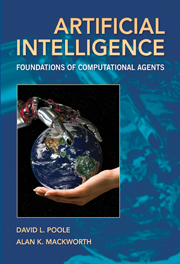Book contents
- Frontmatter
- Contents
- Preface
- I Agents in the World: What Are Agents and How Can They Be Built?
- 1 Artificial Intelligence and Agents
- 2 Agent Architectures and Hierarchical Control
- II Representing and Reasoning
- III Learning and Planning
- IV Reasoning About Individuals and Relations
- V The Big Picture
- A Mathematical Preliminaries and Notation
- Bibliography
- Index
2 - Agent Architectures and Hierarchical Control
from I - Agents in the World: What Are Agents and How Can They Be Built?
- Frontmatter
- Contents
- Preface
- I Agents in the World: What Are Agents and How Can They Be Built?
- 1 Artificial Intelligence and Agents
- 2 Agent Architectures and Hierarchical Control
- II Representing and Reasoning
- III Learning and Planning
- IV Reasoning About Individuals and Relations
- V The Big Picture
- A Mathematical Preliminaries and Notation
- Bibliography
- Index
Summary
By a hierarchic system, or hierarchy, I mean a system that is composed of interrelated subsystems, each of the latter being in turn hierarchic in structure until we reach some lowest level of elementary subsystem. In most systems of nature it is somewhat arbitrary as to where we leave off the partitioning and what subsystems we take as elementary. Physics makes much use of the concept of “elementary particle,” although the particles have a disconcerting tendency not to remain elementary very long …
Empirically a large proportion of the complex systems we observe in nature exhibit hierarchic structure. On theoretical grounds we would expect complex systems to be hierarchies in a world in which complexity had to evolve from simplicity.
–Herbert A. Simon [1996]This chapter discusses how an intelligent agent can perceive, reason, and act over time in an environment. In particular, it considers the internal structure of an agent. As Simon points out in the quote above, hierarchical decomposition is an important part of the design of complex systems such as intelligent agents. This chapter presents ways to design agents in terms of hierarchical decompositions and ways that agents can be built, taking into account the knowledge that an agent needs to act intelligently.
Information
- Type
- Chapter
- Information
- Artificial IntelligenceFoundations of Computational Agents, pp. 43 - 68Publisher: Cambridge University PressPrint publication year: 2010
Accessibility standard: Unknown
Why this information is here
This section outlines the accessibility features of this content - including support for screen readers, full keyboard navigation and high-contrast display options. This may not be relevant for you.Accessibility Information
- 1
- Cited by
